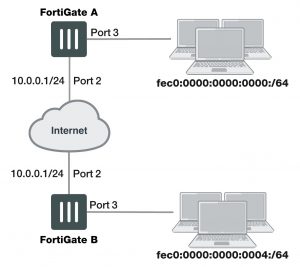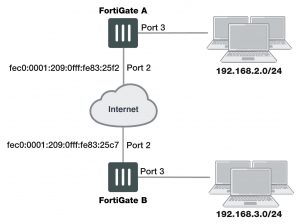Redundant route-based VPN configuration example
This example demonstrates a fully redundant site-to-site VPN configuration using route-based VPNs. At each site, the FortiGate unit has two interfaces connected to the Internet through different ISPs. This means that there are four possible paths for communication between the two units. In this example, these paths, listed in descending priority, are:
- FortiGate_1 WAN 1 to FortiGate_2 WAN 1
- FortiGate_1 WAN 1 to FortiGate_2 WAN 2
- FortiGate_1 WAN 2 to FortiGate_2 WAN 1
- FortiGate_1 WAN 2 to FortiGate_2 WAN 2
Example redundant route-based VPN configuration
For each path, VPN configuration, security policies and routing are defined. By specifying a different routing distance for each path, the paths are prioritized. A VPN tunnel is established on each path, but only the highest priority one is used. If the highest priority path goes down, the traffic is automatically routed over the next highest priority path. You could use dynamic routing, but to keep this example simple, static routing is used.
Configuring FortiGate_1
When configuring FortiGate_1, you must:
- Configure the interfaces involved in the VPN.
- Define the Phase 1 configuration for each of the four possible paths, creating a virtual IPsec interface for each one.
- Define the Phase 2 configuration for each of the four possible paths.
- Configure routes for the four IPsec interfaces, assigning the appropriate priorities.
- Configure incoming and outgoing security policies between the internal interface and each of the virtual IPsec interfaces.
To configure the network interfaces
1. Go to Network > Interfaces.
2. Select the Internal interface and select Edit.
3. Enter the following information and then select OK:
Addressing mode Manual
IP/Netmask 10.21.101.0/255.255.255.0
4. Select the WAN1 interface and select Edit, enter the following information and then select OK:
Addressing mode Manual
IP/Netmask 192.168.10.2/255.255.255.0
5. Select the WAN2 interface and select Edit, enter the following information and then select OK:
Addressing mode Manual
IP/Netmask 172.16.20.2/255.255.255.0
To configure the IPsec interfaces (Phase 1 configurations)
1. Go to VPN > IPsec Tunnels and create the new custom tunnel or edit an existing tunnel.
2. Edit the Phase 1 Proposal (if it is not available, you may need to click the Convert to Custom Tunnel button).
3. Enter the following information, and select OK:
Name Site_1_A
Remote Gateway Static IP Address
IP Address 192.168.20.2
Local Interface WAN1
Mode Main
Authentication Method Preshared Key
Pre–shared Key Enter the preshared key.
Peer Options Any peer ID
Advanced
Dead Peer Detection Select
4. Create a new tunnel and enter the following Phase 1 information:
Name Site_1_B
Remote Gateway Static IP Address
IP Address 172.16.30.2
Local Interface WAN1
Mode Main
Authentication Method Preshared Key
Pre–shared Key Enter the preshared key.
Peer Options Any peer ID
Advanced
Dead Peer Detection Select
5. Create a new tunnel and enter the following Phase 1 information:
Name Site_1_C
Remote Gateway Static IP Address
IP Address 192.168.20.2
Local Interface WAN2
Mode Main
Authentication Method Preshared Key
Pre–shared Key Enter the preshared key.
Peer Options Any peer ID
Advanced
Dead Peer Detection Select
6. Create a new tunnel and enter the following Phase 1 information:
Name Site_1_D
Remote Gateway Static IP Address
IP Address 172.16.30.2
Local Interface WAN2
Mode Main
Authentication Method Preshared Key
Pre–shared Key Enter the preshared key.
Peer Options Any peer ID
Advanced
Dead Peer Detection Select
To define the Phase 2 configurations for the four VPNs
1. Open the Phase 2 Selectors panel.
2. Enter the following information and select OK:
Name Route_A
Phase 1 Site_1_A
3. Enter the following Phase 2 information for the subsequent route:
Name Route_B
Phase 1 Site_1_B
4. Enter the following Phase 2 information for the subsequent route:
Name Route_C
Phase 1 Site_1_C
5. Enter the following Phase 2 information for the subsequent route:
Name Route_D
Phase 1 Site_1_D
To configure routes
1. Go to Network > Static Routes.
2. Select Create New, enter the following default gateway information and then select OK:
Destination IP/Mask 0.0.0.0/0.0.0.0
Device WAN1
Gateway 192.168.10.1
Distance (Advanced) 10
3. Select Create New, enter the following information and then select OK:
Destination IP/Mask 10.31.101.0/255.255.255.0
Device Site_1_A
Distance (Advanced) 1
4. Select Create New, enter the following information and then select OK:
Destination IP/Mask 10.31.101.0/255.255.255.0
Device Site_1_B
Distance (Advanced) 2
5. Select Create New, enter the following information and then select OK:
Destination IP/Mask 10.31.101.0/255.255.255.0
Device Site_1_C
Distance (Advanced) 3
6. Select Create New, enter the following information and then select OK:
Destination IP/Mask 10.31.101.0/255.255.255.0
Device Site_1_D
Distance (Advanced) 4
To configure security policies
1. Go to Policy & Objects > IPv4 Policy and select Create New.
2. Enter the following information, and then select OK:
Incoming Interface Internal
Source Address All
Outgoing Interface Site_1_A
Destination Address All
Schedule Always
Service Any
Action ACCEPT
3. Select Create New.
4. Enter the following information, and select OK:
Incoming Interface Site_1_A
Source Address All
Outgoing Interface Internal
Destination Address All
Schedule Always
Service Any
Action ACCEPT
5. Select Create New.
6. Enter the following information, and select OK:
Incoming Interface Internal
Source Address All
Outgoing Interface Site_1_B
Destination Address All
Schedule Always
Service Any
Action ACCEPT
7. Select Create New.
8. Enter the following information, and select OK:
Incoming Interface Site_1_B
Source Address All
Outgoing Interface Internal
Destination Address All
Schedule Always
Service Any
Action ACCEPT
9. Select Create New.
10. Enter the following information, and select OK:
Incoming Interface Internal
Source Address All
Outgoing Interface Site_1_C
Destination Address All
Schedule Always
Service Any
Action ACCEPT
11. Select Create New.
12. Enter the following information, and select OK:
Incoming Interface Site_1_C
Source Address All
Outgoing Interface Internal
Destination Address All
Schedule Always
Service Any
Action ACCEPT
13. Select Create New.
14. Enter the following information, and select OK:
Incoming Interface Internal
Source Address All
Outgoing Interface Site_1_D
Destination Address All
Schedule Always
Service Any
Action ACCEPT
5. Select Create New.
16. Enter the following information, and select OK:
Incoming Interface Site_1_D
Source Address All
Outgoing Interface Internal
Destination Address All
Schedule Always
Service Any
Action ACCEPT
Configuring FortiGate_2
The configuration for FortiGate_2 is very similar to that of FortiGate_1. You must:
- Configure the interfaces involved in the VPN.
- Define the Phase 1 configuration for each of the four possible paths, creating a virtual IPsec interface for each one.
- Define the Phase 2 configuration for each of the four possible paths.
- Configure routes for the four IPsec interfaces, assigning the appropriate priorities.
- Configure incoming and outgoing security policies between the internal interface and each of the virtual IPsec interfaces.
To configure the network interfaces
1. Go to Network > Interfaces.
2. Select the Internal interface and then select Edit. Enter the following information and then select OK:
Addressing mode Manual
IP/Netmask 10.31.101.0/255.255.255.0
3. Select the WAN1 interface and then select Edit. Enter the following information and then select OK:
Addressing mode Manual
IP/Netmask 192.168.20.2/255.255.255.0
4. Select the WAN2 interface and then select Edit. Enter the following information and then select OK:
Addressing mode Manual
IP/Netmask 172.16.30.2/255.255.255.0
To configure the IPsec interfaces (Phase 1 configurations)
1. Go to VPN > IPsec Tunnels and create the new custom tunnel or edit an existing tunnel.
2. Edit the Phase 1 Proposal (if it is not available, you may need to click the Convert to Custom Tunnel button).
3. Enter the following information, and select OK:
Name Site_2_A
Remote Gateway Static IP Address
IP Address 192.168.10.2
Local Interface WAN1
Mode Main
Authentication Method Preshared Key
Pre–shared Key Enter the preshared key.
Peer Options Any peer ID
Advanced
Dead Peer Detection Select
4. Create a new tunnel and enter the following Phase 1 information:
Name Site_2_B
Remote Gateway Static IP Address
IP Address 172.16.20.2
Local Interface WAN1
Mode Main
Authentication Method Preshared Key
Pre–shared Key Enter the preshared key.
Peer Options Any peer ID
Advanced
Dead Peer Detection Select
5. Create a new tunnel and enter the following Phase 1 information:
Name Site_2_C
Remote Gateway Static IP Address
IP Address 192.168.10.2
Local Interface WAN1
Mode Main
Authentication Method Preshared Key
Pre–shared Key Enter the preshared key.
Peer Options Any peer ID
Advanced
Dead Peer Detection Select
6. Create a new tunnel and enter the following Phase 1 information:
Name Site_2_D
Remote Gateway Static IP Address
IP Address 172.16.20.2
Local Interface WAN1
Mode Main
Authentication Method Preshared Key
Pre–shared Key Enter the preshared key.
Peer Options Any peer ID
Advanced
Dead Peer Detection Select
To define the Phase 2 configurations for the four VPNs
1. On the first VPN route, open the Phase 2 Selectors panel.
2. Enter the following information and select OK:
Name Route_A
Phase 1 Site_2_A
3. Enter the following Phase 2 information for the subsequent route:
Name Route_B
Phase 1 Site_2_B
4. Enter the following Phase 2 information for the subsequent route:
Name Route_C
Phase 1 Site_2_C
5. Enter the following Phase 2 information for the subsequent route:
Name Route_D
Phase 1 Site_2_D
To configure routes
1. Go to Network > Static Routes.
2. Select Create New, enter the following default gateway information and then select OK:
Destination IP/Mask 0.0.0.0/0.0.0.0
Device WAN1
Gateway 192.168.10.1
Distance (Advanced) 10
3. Select Create New, enter the following information and then select OK:
Destination IP/Mask 10.21.101.0/255.255.255.0
Device Site_2_A
Distance (Advanced) 1
4. Select Create New, enter the following information and then select OK:
Destination IP/Mask 10.21.101.0/255.255.255.0
Device Site_2_B
Distance (Advanced) 2
5. Select Create New, enter the following information and then select OK:
Destination IP/Mask 10.21.101.0/255.255.255.0
Device Site_2_C
Distance (Advanced) 3
6. Select Create New, enter the following information and then select OK:
Destination IP/Mask 10.21.101.0/255.255.255.0
Device Site_2_D
Distance (Advanced) 4
To configure security policies
1. Go to Policy & Objects > IPv4 Policy and select Create New.
2. Enter the following information, and select OK:
Incoming Interface Internal
Source Address All
Outgoing Interface Site_2_A
Destination Address All
Schedule Always
Service Any
Action ACCEPT
3. Select Create New.
4. Enter the following information, and select OK:
Incoming Interface Site_2_A
Source Address All
Outgoing Interface Internal
Destination Address All
Schedule Always
Service Any
Action ACCEPT
5. Select Create New.
6. Enter the following information, and select OK:
Incoming Interface Internal
Source Address All
Outgoing Interface Site_2_B
Destination Address All
Schedule Always
Service Any
Action ACCEPT
7. Select Create New.
8. Enter the following information, and select OK:
Incoming Interface Site_2_B
Source Address All
Outgoing Interface Internal
Destination Address All
Schedule Always
Service Any
Action ACCEPT
9. Select Create New.
10. Enter the following information, and select OK:
Incoming Interface Internal
Source Address All
Outgoing Interface Site_2_C
Destination Address All
Schedule Always
Service Any
Action ACCEPT
11. Select Create New.
12. Enter the following information, and select OK:
Incoming Interface Site_2_C
Source Address All
Outgoing Interface Internal
Destination Address All
Schedule Always
Service Any
Action ACCEPT
13. Select Create New.
14. Enter the following information, and select OK:
Incoming Interface Internal
Source Address All
Outgoing Interface Site_2_D
Destination Address All
Schedule Always
Service Any
Action ACCEPT
15. Select Create New.
16. Enter the following information, and select OK:
Incoming Interface Site_2_D
Source Address All
Outgoing Interface Internal
Destination Address All
Schedule Always
Service Any
Action ACCEPT


